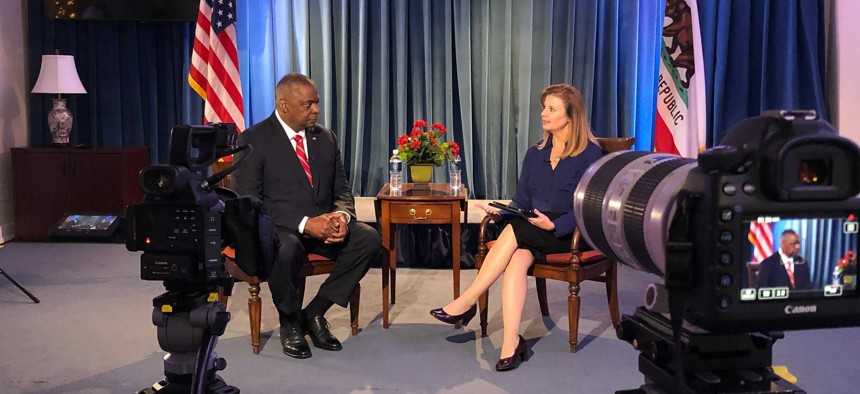TARA COPP

Defense Secretary Lloyd Austin, who served as a general during several Middle East wars, is used to the military charting the U.S. path in conflict zones. But that emphasis began to shift years ago, as the State Department took the lead during the Obama, Trump, and now Biden administrations.
This diplomat-led approach may meet its biggest test to date in Ukraine and Taiwan, two fronts where U.S. policy about direct military intervention is not clear, and where Russia and China are now testing the edges.
In an exclusive interview with Defense One, Austin revealed a bit of his thinking on both fronts.
“Our goal in both cases …is to lead with diplomacy, and address these issues in a way that we don't get into conflict,” Austin told Defense One during his Outlook 2022 interview.
Joe Biden and Vladimir Putin will speak on Tuesday about Ukraine, where the U.S. president is expected to warn of dire economic consequences if Russia launches a sequel to its 2014 invasion. Russia has deployed “battalion tactical groups around Ukraine in multiple different geographies around those borders to the south, the west, and to the northeast as well,” which is a concerning echo of Moscow’s buildup before it annexed Crimea, a senior U.S. official told reporters on Monday.
The official suggested that if an invasion occurs, more U.S. troops in Europe may follow to reassure allies.
“The need to reinforce the confidence and reassurance of our NATO allies and our eastern flank allies would be real, and the United States would be prepared to provide that kind of reassurance,” the official said.
This diplomatic-led approach is an early inkling of the Pentagon and White House policy of "integrated deterrence,” which Austin said will be a cornerstone of the upcoming National Defense Strategy. The strategy is expected to explicitly turn away from military-first pressure and in favor of diplomatic, economic and international pressure, backed by the military.
Ukraine and Taiwan may be early tests of that approach.
Ukraine is not a member of NATO and does not receive Article 5 protections from the alliance. But the country does receive regular rotations of U.S. troops and sales of weapons to bolster its self-defense. Taiwan is recognized by the Taiwan Relations Act, under which the U.S. provides weapons and training to Taiwan so it too can defend itself. But neither is guaranteed U.S. military protection in case of an attack.
Since 2014, U.S troops have regularly rotated into Ukraine to train and advise Ukrainian forces. Austin did not say whether those U.S. forces would fight alongside their Ukrainian partners in case of an attack, or what might spur a U.S. military response.
“I think in situations like this, I think conveying red lines only exacerbates the problem. I think we need to focus on finding ways to de-escalate and reduce tensions,” Austin said.
Pressed on whether there was any advantage to communicating a “red line” to avoid miscalculation by Russian forces, Austin said he would leave it to the Ukrainian government to call out Russia.
“I don't think it's helpful for us to draw a line in the sand at this point,” Austin said.
In Taiwan, Austin had a similar message: “We don't want to see change in the status quo, especially, certainly a unilateral change in the status quo. We think that all tensions in that area should be resolved diplomatically first.”
No comments:
Post a Comment